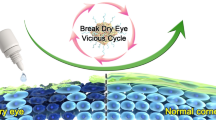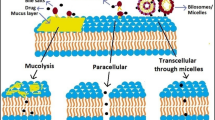Abstract
Purpose
The aim of this study was to evaluate the contribution of amino acid transporters in the transcorneal permeation of the aspartate (Asp) ester acyclovir (ACV) prodrug.
Methods
Physicochemical characterization, solubility and stability of acyclovir l-aspartate (l-Asp-ACV) and acyclovir d-aspartate (d-Asp-ACV) were studied. Transcorneal permeability was evaluated across excised rabbit cornea.
Results
Solubility of l-Asp-ACV and d-Asp-ACV were about twofold higher than that of ACV. The prodrugs demonstrated greater stability under acidic conditions. Calculated pKa and logP values for both prodrugs were identical. Transcorneal permeability of l-Asp-ACV \(\left( {{\text{12}}{\text{.1}} \pm {\text{1}}{\text{.48}} \times {\text{10}}^{ - {\text{6}}} {{{\text{cm}}} \mathord{\left/ {\vphantom {{{\text{cm}}} {\text{s}}}} \right. \kern-\nulldelimiterspace} {\text{s}}}} \right)\) was fourfold higher than d-Asp-ACV \(\left( {{\text{3}}{\text{.12}} \pm {\text{0}}{\text{.36}} \times {\text{10}}^{ - {\text{6}}} {{{\text{cm}}} \mathord{\left/ {\vphantom {{{\text{cm}}} {\text{s}}}} \right. \kern-\nulldelimiterspace} {\text{s}}}} \right)\) and ACV \(\left( {{\text{3}}{\text{.25}} \pm {\text{0}}{\text{.56}} \times {\text{10}}^{ - {\text{6}}} {{{\text{cm}}} \mathord{\left/ {\vphantom {{{\text{cm}}} {\text{s}}}} \right. \kern-\nulldelimiterspace} {\text{s}}}} \right)\). ACV generation during the transport process was minimal. l-Asp-ACV transport was sodium and energy dependent but was not inhibited by glutamic acid. Addition of BCH, a specific B0,+ and L amino acid transporter inhibitor, decreased transcorneal l-Asp-ACV permeability to \({\text{2}}{\text{.66}} \pm {\text{0}}{\text{.21}} \times {\text{10}}^{ - {\text{6}}} {{{\text{cm}}} \mathord{\left/ {\vphantom {{{\text{cm}}} {\text{s}}}} \right. \kern-\nulldelimiterspace} {\text{s}}}\). l-Asp-ACV and d-Asp-ACV did not demonstrate significant difference in stability in ocular tissue homogenates.
Conclusion
The results demonstrate that enhanced transport of l-Asp-ACV is as a result of corneal transporter involvement (probably amino acid transporter B0,+) and not as a result of changes in physicochemical properties due to prodrug derivatization (permeability of d-Asp-ACV and ACV were not significantly different).






Similar content being viewed by others
References
I. P. Kaur, and R. Smitha. Penetration enhancers and ocular bioadhesives: two new avenues for ophthalmic drug delivery. Drug Dev. Ind. Pharm. 28:353–369 (2002). doi:10.1081/DDC-120002997.
E. Mannermaa, K. S. Vellonen, and A. Urtti. Drug transport in corneal epithelium and blood–retina barrier: emerging role of transporters in ocular pharmacokinetics. Adv. Drug Deliv. Rev. 58:1136–1163 (2006). doi:10.1016/j.addr.2006.07.024.
D. A. Jabs. Acyclovir for recurrent herpes simplex virus ocular disease. N. Engl. J. Med. 339:340–341 (1998). doi:10.1056/NEJM199807303390510.
S. Guess, D. U. Stone, and J. Chodosh. Evidence-based treatment of herpes simplex virus keratitis: a systematic review. Ocul. Surf. 5:240–250 (2007).
K. R. Wilhelmus. The treatment of herpes simplex virus epithelial keratitis. Trans. Am. Ophthalmol. Soc. 98:505–532 (2000).
K. R. Wilhelmus. Therapeutic interventions for herpes simplex virus epithelial keratitis. Cochrane Database Syst. Rev. CD002898 (2007).
P. Chetoni, S. Rossi, S. Burgalassi, D. Monti, S. Mariotti, and M. F. Saettone. Comparison of liposome-encapsulated acyclovir with acyclovir ointment: ocular pharmacokinetics in rabbits. J Ocul Pharmacol Ther. 20:169–177 (2004). doi:10.1089/108076804773710849.
S. Ghosh, V. Jhanji, E. Lamoureux, H. R. Taylor, and R. B. Vajpayee. Acyclovir therapy in prevention of recurrent herpetic keratitis following penetrating keratoplasty. Am. J. Ophthalmol. 145:198–202 (2008). doi:10.1016/j.ajo.2007.10.005.
S. Majumdar, Y. E. Nashed, K. Patel, R. Jain, M. Itahashi, D. M. Neumann, J. M. Hill, and A. K. Mitra. Dipeptide monoester ganciclovir prodrugs for treating HSV-1-induced corneal epithelial and stromal keratitis: in vitro and in vivo evaluations. J. Ocul. Pharmacol. Ther. 21:463–474 (2005). doi:10.1089/jop.2005.21.463.
S. Y. Lee. Herpes simplex virus ocular infections. Drugs Today (Barc). 34:241–249 (1998). doi:10.1358/dot.1998.34.3.485179.
A. Simmons. Clinical manifestations and treatment considerations of herpes simplex virus infection. J. Infect Dis. 186(Suppl 1):S71–S77 (2002). doi:10.1086/342967.
M. Fresta, G. Fontana, C. Bucolo, G. Cavallaro, G. Giammona, and G. Puglisi. Ocular tolerability and in vivo bioavailability of poly(ethylene glycol) (PEG)-coated polyethyl-2-cyanoacrylate nanosphere-encapsulated acyclovir. J. Pharm. Sci. 90:288–97 (2001). doi:10.1002/1520-6017(200103)90:3<288::AID-JPS4>3.0.CO;2-5.
S. L. Law, K. J. Huang, and C. H. Chiang. Acyclovir-containing liposomes for potential ocular delivery. Corneal penetration and absorption. J. Control Release. 63:135–140 (2000). doi:10.1016/S0168-3659(99)00192-3.
B. Wang, W. Teng, and X. Han. An experimental study of a new route for acyclovir administration for anti-keratitis therapeutic treatment. Zhonghua Shi Yan He Lin Chuang Bing Du Xue Za Zhi. 14:379–381 (2000).
S. Majumdar, K. Hippalgaonkar, and M. A. Repka. Effect of chitosan, benzalkonium chloride and ethylenediaminetetraacetic acid on permeation of acyclovir across isolated rabbit cornea. Int. J. Pharm. 348:175–178 (2008). doi:10.1016/j.ijpharm.2007.08.017.
S. Majumdar, S. Duvvuri, and A. K. Mitra. Membrane transporter/receptor-targeted prodrug design: strategies for human and veterinary drug development. Adv. Drug Deliv. Rev. 56:1437–1452 (2004). doi:10.1016/j.addr.2004.02.006.
M. Palacin, R. Estevez, J. Bertran, and A. Zorzano. Molecular biology of mammalian plasma membrane amino acid transporters. Physiol. Rev. 78:969–1054 (1998).
B. Anand, Y. Nashed, and A. Mitra. Novel dipeptide prodrugs of acyclovir for ocular herpes infections: Bioreversion, antiviral activity and transport across rabbit cornea. Curr Eye Res. 26:151–163 (2003). doi:10.1076/ceyr.26.3.151.14893.
B. S. Anand, and A. K. Mitra. Mechanism of corneal permeation of l-valyl ester of acyclovir: targeting the oligopeptide transporter on the rabbit cornea. Pharm. Res. 19:1194–1202 (2002). doi:10.1023/A:1019806411610.
M. E. Ganapathy, and V. Ganapathy. Amino acid transporter ATB0,+ as a delivery system for drugs and prodrugs. Curr. Drug Targets Immune. Endocr. Metabol. Disord. 5:357–364 (2005). doi:10.2174/156800805774912953.
T. Hatanaka, M. Haramura, Y. J. Fei, S. Miyauchi, C. C. Bridges, P. S. Ganapathy, S. B. Smith, V. Ganapathy, and M. E. Ganapathy. Transport of amino acid-based prodrugs by the Na+- and Cl(−) -coupled amino acid transporter ATB0,+ and expression of the transporter in tissues amenable for drug delivery. J. Pharmacol. Exp. Ther. 308:1138–1147 (2004). doi:10.1124/jpet.103.057109.
K. Patel, S. Trivedi, S. Luo, X. Zhu, D. Pal, E. R. Kern, and A. K. Mitra. Synthesis, physicochemical properties and antiviral activities of ester prodrugs of ganciclovir. Int. J. Pharm. 305:75–89 (2005). doi:10.1016/j.ijpharm.2005.08.024.
C. Santos, J. Morais, L. Gouveia, E. de Clercq, C. Pannecouque, C. U. Nielsen, B. Steffansen, R. Moreira, and P. Gomes. Dipeptide derivatives of AZT: synthesis, chemical stability, activation in human plasma, hPEPT1 affinity, and antiviral activity. ChemMedChem. 3:970–978 (2008).
B. S. Anand, S. Katragadda, Y. E. Nashed, and A. K. Mitra. Amino acid prodrugs of acyclovir as possible antiviral agents against ocular HSV-1 infections: interactions with the neutral and cationic amino acid transporter on the corneal epithelium. Curr. Eye Res. 29:153–166 (2004). doi:10.1080/02713680490504614.
L. M. Beauchamp, G. F. Orr, P. de Miranda, T. Burnette, and T. A. Krenitsky. Amino acid ester prodrugs of acyclovir. Antivir. Chem. Chemother. 3:157–164 (1992).
United States Pharmacopeial Commission. The United States Pharmacopoeia XXX, NF XXV, United States Pharmacopeial Commission, Inc., Rockville, MD, 2006, 806–807.
M. M. Bradford. A rapid and sensitive method for the quantitation of microgram quantities of protein utilizing the principle of protein-dye binding. Anal. Biochem. 72:248–254 (1976). doi:10.1016/0003-2697(76)90527-3.
B. Garre, K. Shebany, A. Gryspeerdt, K. Baert, K. van der Meulen, H. Nauwynck, P. Deprez, P. De Backer, and S. Croubels. Pharmacokinetics of acyclovir after intravenous infusion of acyclovir and after oral administration of acyclovir and its prodrug valacyclovir in healthy adult horses. Antimicrob. Agents Chemother. 51:4308–4314 (2007). doi:10.1128/AAC.00116-07.
B. Jain-Vakkalagadda, S. Dey, D. Pal, and A. K. Mitra. Identification and functional characterization of a Na+-independent large neutral amino acid transporter, LAT1, in human and rabbit cornea. Invest. Ophthalmol. Vis. Sci. 44:2919–2927 (2003). doi:10.1167/iovs.02-0907.
B. Jain-Vakkalagadda, D. Pal, S. Gunda, Y. Nashed, V. Ganapathy, and A. K. Mitra. Identification of a Na+-dependent cationic and neutral amino acid transporter, B(0,+), in human and rabbit cornea. Mol. Pharm. 1:338–346 (2004). doi:10.1021/mp0499499.
C. Yang, H. Gao, and A. K. Mitra. Chemical stability, enzymatic hydrolysis, and nasal uptake of amino acid ester prodrugs of acyclovir. J. Pharm. Sci. 90:617–624 (2001). doi::10.1002/1520-6017(200105)90:5<617::AID-JPS1018>3.0.CO;2-5.
H. Bundgaard, E. Jensen, and E. Falch. Water-soluble, solution-stable, and biolabile N-substituted (aminomethyl)benzoate ester prodrugs of acyclovir. Pharm. Res. 8:1087–1093 (1991). doi:10.1023/A:1015837931256.
C. G. Jordan. How an increase in the carbon chain length of the ester moiety affects the stability of a homologous series of oxprenolol esters in the presence of biological enzymes. J. Pharm. Sci. 87:880–885 (1998). doi:10.1021/js970280p.
S. C. Chang, and V. H. Lee. Influence of chain length on the in vitro hydrolysis of model ester prodrugs by ocular esterases. Curr. Eye Res. 2:651–656 (1982). doi:10.3109/02713688209019993.
D. S. Chien, H. Sasaki, H. Bundgaard, A. Buur, and V. H. Lee. Role of enzymatic lability in the corneal and conjunctival penetration of timolol ester prodrugs in the pigmented rabbit. Pharm. Res. 8:728–733 (1991). doi:10.1023/A:1015845916293.
Acknowledgement
This project was supported by NIH grant numbers P20RR021929, from the National Center for Research Resources, and EY018426-01 from the National Eye Institute. The content is solely the responsibility of the authors and does not necessarily represent the official views of the National Center for Research Resources or the National Institutes of Health.
Author information
Authors and Affiliations
Corresponding author
Electronic supplementary material
Below is the link to the electronic supplementary material.
Fig. S-1
Proton NMR (500 MHz) of l-Asp-ACV in DMSO (DOC 299 KB)
Fig. S-2
Proton NMR (500 MHz) of d-Asp-ACV in DMSO (DOC 81 KB)
Fig. S-3
13C NMR of l-Asp-ACV in DMSO (DOC 181 KB)
Fig. S-4
13C DEPT NMR of d-Asp-ACV in DMSO (DOC 75.5 KB)
Fig. S-5
13C NMR of d-Asp-ACV (DOC 88.5 KB)
Fig. S-6
Proton NMR of intermediate compound (3l-Ester of ACV) (DOC 184 KB)
Fig. S-7
Proton NMR of intermediate compound (3d-Ester) (DOC 78.5 KB)
Fig. S-8
13C NMR of intermediate compound (3l-ester) (DOC 82 KB)
Fig. S-9
13C NMR of intermediate compound (3d-ester) in DMSO (DOC 79 KB)
Fig. S-10
13C DEPT NMR of intermediate compound (3d-ester) in DMSO (DOC 78 KB)
Fig. S-11
LC-MS data for d-Asp-ACV and l-Asp-ACV (DOC 518 KB)
Rights and permissions
About this article
Cite this article
Majumdar, S., Hingorani, T., Srirangam, R. et al. Transcorneal Permeation of l- and d-Aspartate Ester Prodrugs of Acyclovir: Delineation of Passive Diffusion Versus Transporter Involvement. Pharm Res 26, 1261–1269 (2009). https://doi.org/10.1007/s11095-008-9730-0
Received:
Accepted:
Published:
Issue Date:
DOI: https://doi.org/10.1007/s11095-008-9730-0




